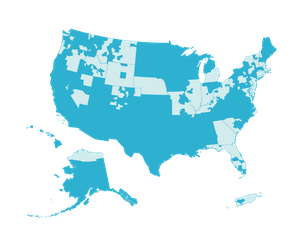In a wide-ranging interview with Affordable Housing Finance, VP and director of Rural LISC Caitlin Cain lists the top ways to build robust and sustainable rural economies and reveals what keeps her up at night (and her predictions for the next Super Bowl).
The excerpt below was originally published by:
Affordable Housing Finance
Q&A With LISC's Caitlin Cain
 Caitlin Cain is a vice president at the Local Initiatives Support Corp. (LISC) and director of Rural LISC, which provides a wide range of services, including financial support and technical assistance, to help developers and service partners address obstacles specific to rural communities.
Caitlin Cain is a vice president at the Local Initiatives Support Corp. (LISC) and director of Rural LISC, which provides a wide range of services, including financial support and technical assistance, to help developers and service partners address obstacles specific to rural communities.
She is helping LISC fulfill its Rural Promise, an aspiration to produce 20% of its overall community development impact in rural areas by 2023. Approximately 20% of the country’s population resides in rural America.
Before taking the lead at Rural LISC last year, Cain led her own New Orleans-based social investment firm. She’s also served as CEO of the World Trade Center of New Orleans.
What is your definition of rural?
Rural is really a spectrum with a variety of definitions, but generally, we consider rural to be a community having a population of approximately 50,000 or less.
What is often misunderstood about the needs and opportunities of rural communities?
Rural America is incredibly diverse demographically, culturally, and economically. I think we tend to view rural communities through a narrow lens—impairing our ability to fully appreciate the extent of innovation, entrepreneurship, and cultural richness that characterizes some small towns and rural/remote communities. Some rural areas are home to major employers and research centers, and/or serve as recreation and cultural meccas, while others struggle to retain population and workforce. Because of this diversity, there is no one-size-fits-all investment strategy for rural America. Solving for the complex needs of rural communities—housing, workforce development, infrastructure (including broadband), health care, access to capital—often requires regionalism and a willingness to explore and adopt unique public-private partnerships. Communities that are able to leverage these partnerships are often the ones with the greatest ability to maximize future opportunity.
What is LISC’s Rural Promise? And, where are you on meeting the program’s goal?
Early in 2020, LISC launched the LISC Rural Promise, a commitment to enhance total investment in rural communities to 20% of our impact over the next few years. More recently, LISC rolled out Project 10X—an ambitious, decade-long strategy to address racial gaps in health, wealth, and opportunity that affect millions of people throughout the country, including rural America. Project 10X is a $1 billion plan to raise and deploy capital that will help build a more broadly shared prosperity.
In 2021, Rural LISC operationalized the LISC Rural Promise and Project 10X by providing need-driven technical assistance, training, and access to programs and capital to connect with our partner organizations and rural collaborators in both Black, Indigenous, and People of Color (BIPOC) and non-BIPOC communities throughout rural America. Rural LISC makes these investments through five core pillars to better support, strengthen, and leverage investment in rural ecosystems.
